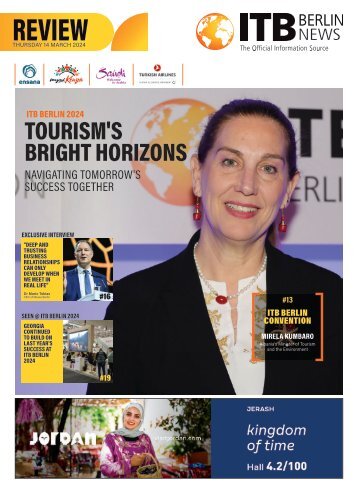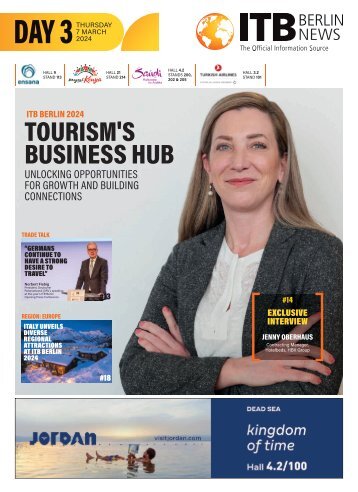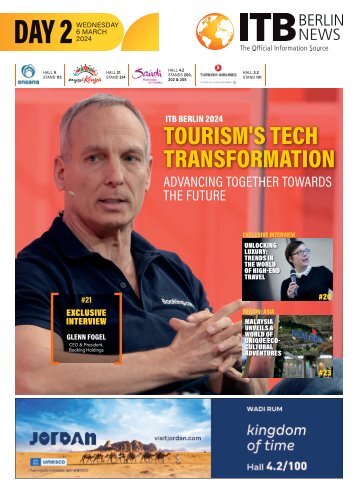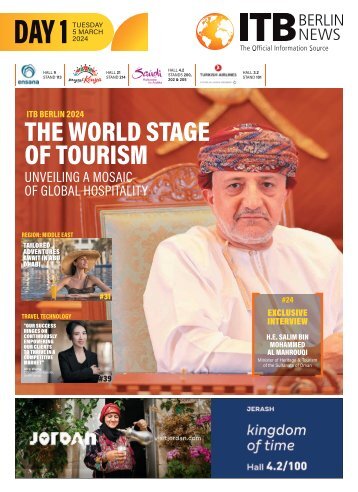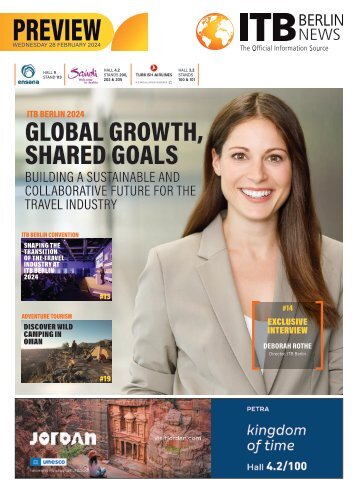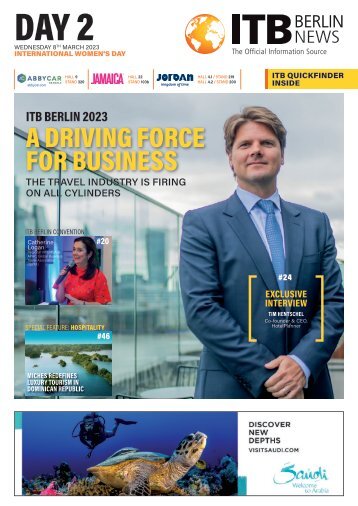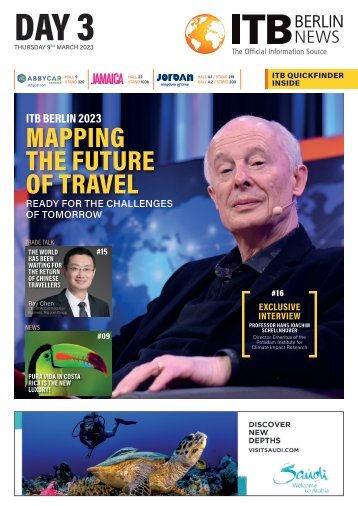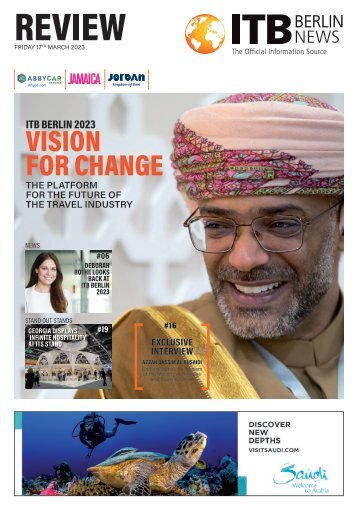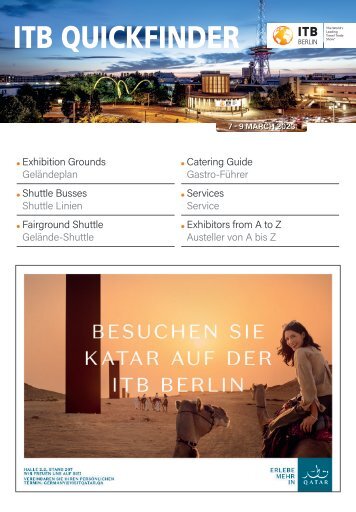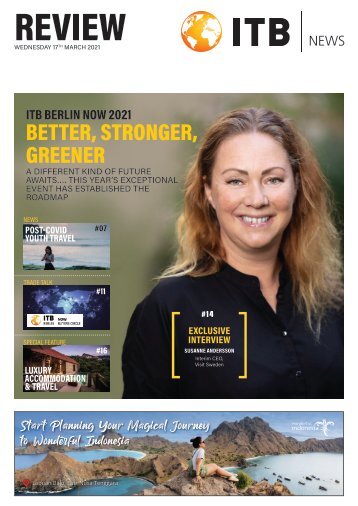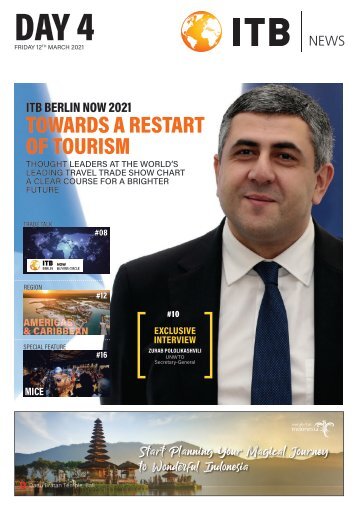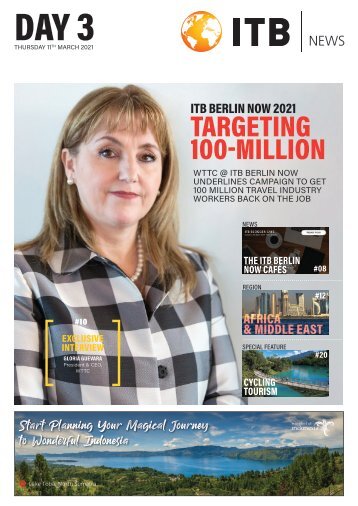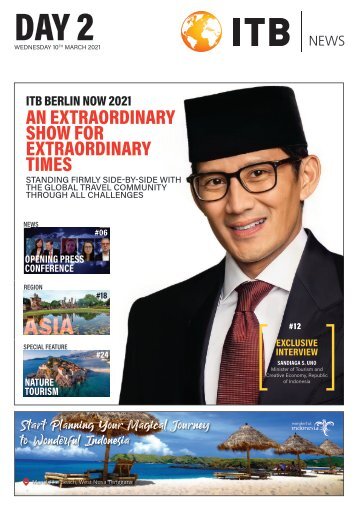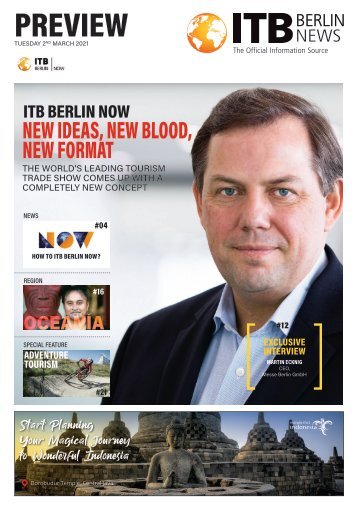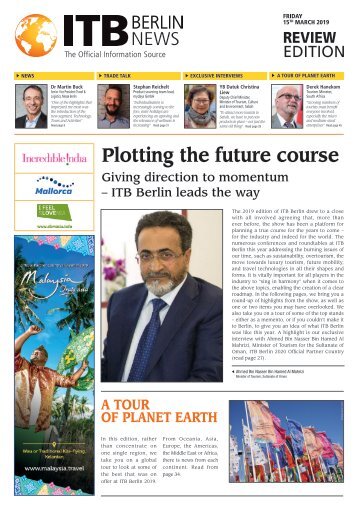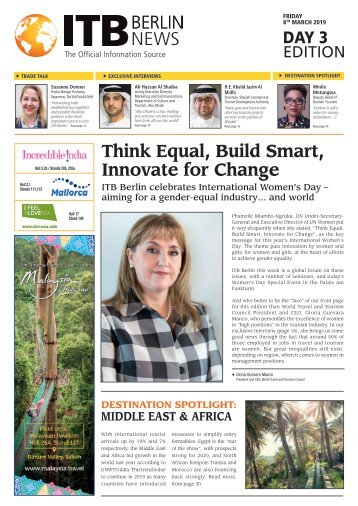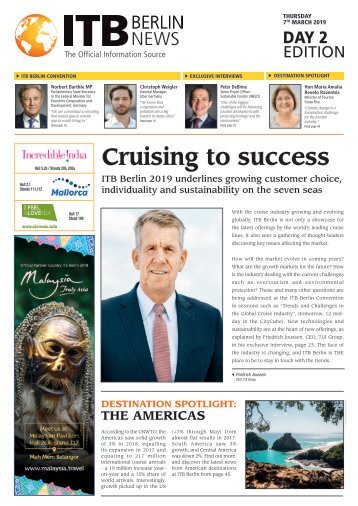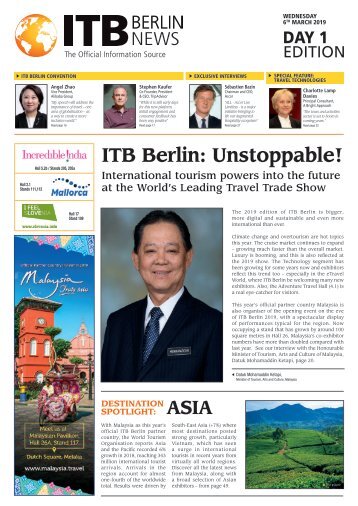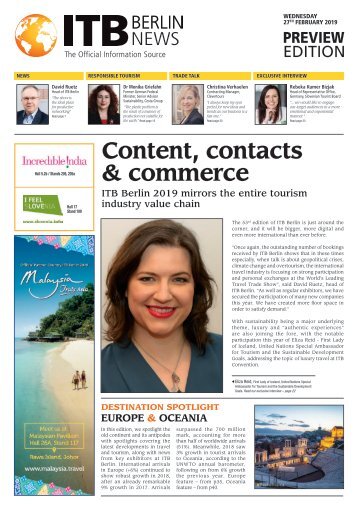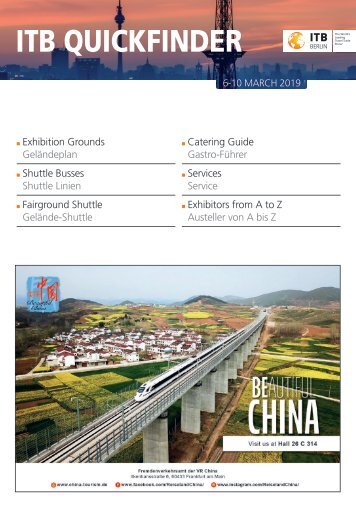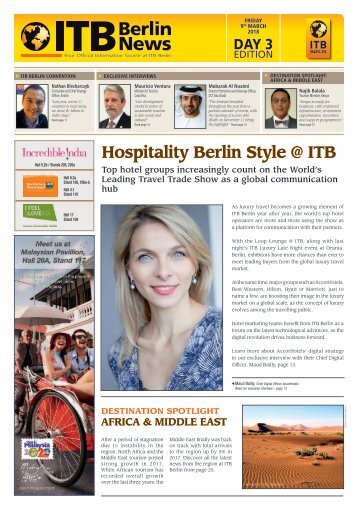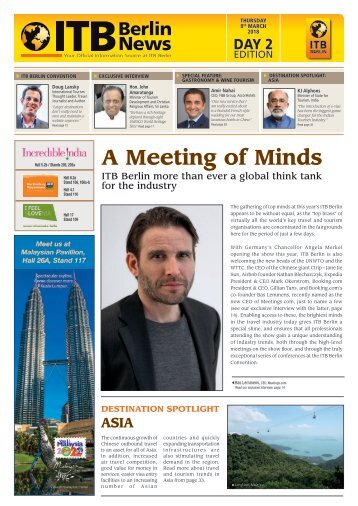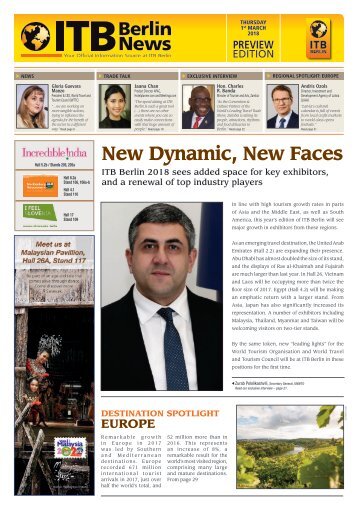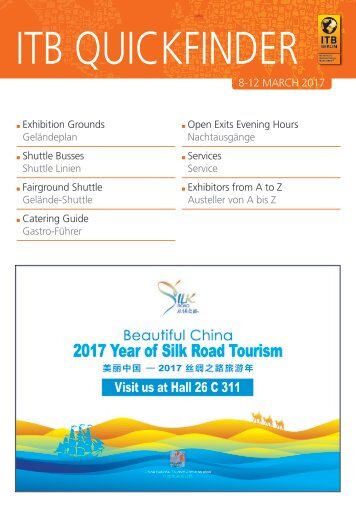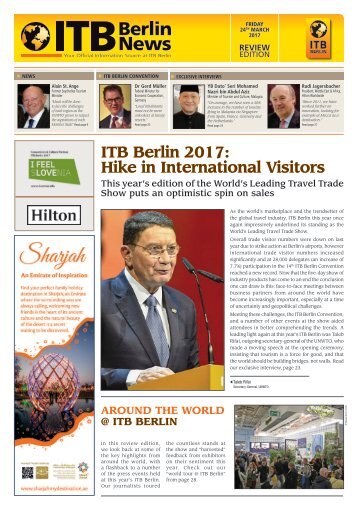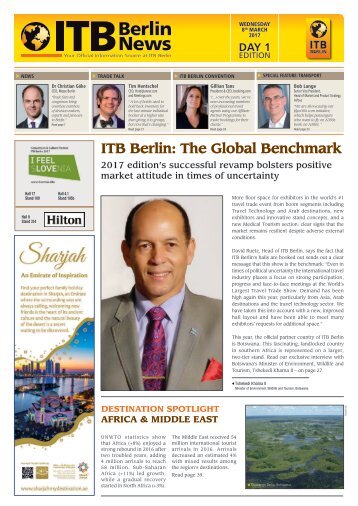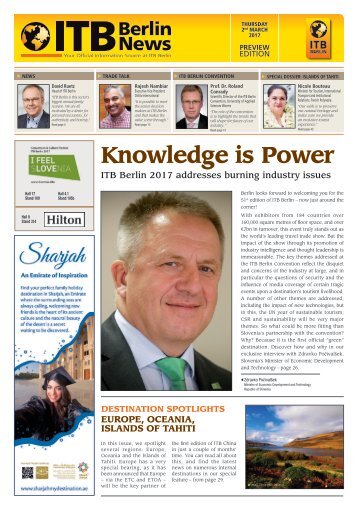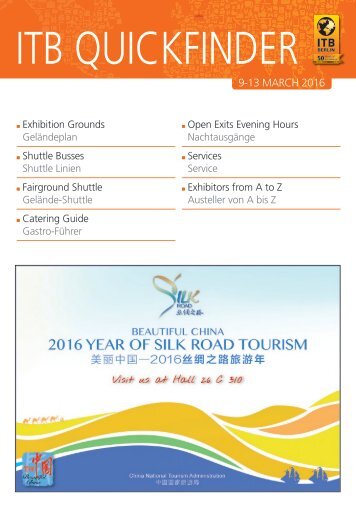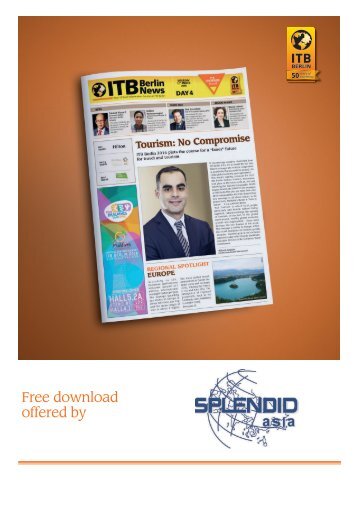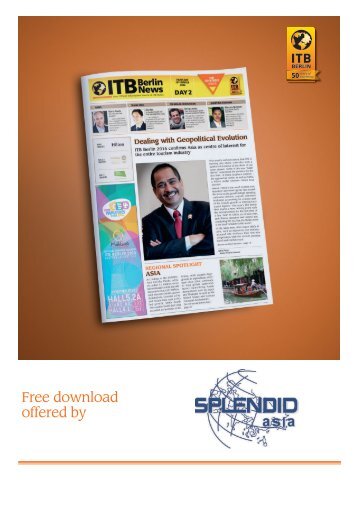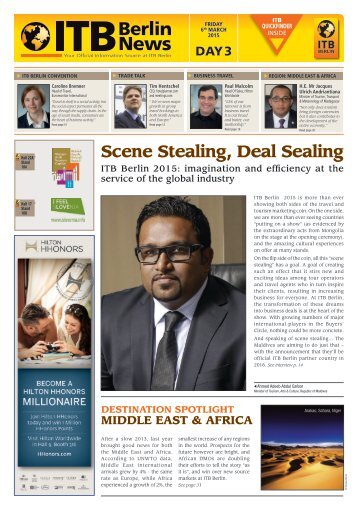
ITB Berlin News - Day 1
- Text
- Hotels
- Tourism
- Resort
- Tours
- Resorts
- Maldives
- Berlin
- Exhibitors
- Halle
- Tourismus
20 EXCLUSIVE INTERVIEW
20 EXCLUSIVE INTERVIEW © Hasselkus PR Citrawarna Malaysia 2007 Authenticity Above All Malaysia’s Minister for Tourism and Culture highlights importance of getting back to nature Dato’ Seri Mohamed Nazri Bin Abdul Aziz Malaysia’s Minister for Tourism and Culture Authenticity is highly important in Malaysia’s tourism thrust. To this end, the country’s tourism ministry has called on local tourist oriented businesses in Sabah to “just go local” – and not to use names that imitate western countries. We asked Malaysia’s Minister for Tourism and Culture, Dato’ Seri Mohamed Nazri Bin Abdul Aziz, present at ITB Berlin, to tell us more. Malaysia’s tourism is founded on the simple tagline, Malaysia Truly Asia, which celebrates the diversity of our local cultures. Therefore, it is only natural that we leverage on our local identity to set ourselves apart from others; that is to say by using local names for our establishments, local ingredients for our food, local raw materials for our souvenirs, and so on. Furthermore, the use of local names is perceived as exotic and authentic to international tourists, and fuels their interest in Malaysia. You have spoken about the importance of culture and nature. What is being done to preserve these assets? The Malaysian Homestay Experience Program, which won the Ulysses Award for Innovation in Public Policy and Governance by the UNWTO in 2012, is a classic example of a rural eco-tourism program, which helps to preserve our cultural and natural assets. The Homestay program underlines the importance of conservation and environmental management. The Tree Planting Program at Homestays is a good example, where visitors are given the opportunity to plant their own tree to mark their visit to that particular Homestay. It also supports the idea of preserving the THE USE OF LOCAL NAMES IS PERCEIVED AS EXOTIC AND AUTHENTIC TO INTERNATIONAL TOURISTS, AND FUELS THEIR INTEREST IN MALAYSIA environment and further beautifying the landscape of the Homestays. To date, more than 16,733 trees have been planted by the homestay visitors. What else are you doing to ensure the slogan “back to nature” is seen as authentic? The Ministry of Tourism and Culture (MOTAC) has formulated a comprehensive plan as part of ongoing initiatives in developing ecotourism sector in Malaysia, This ITB BERLIN NEWS • Wednesday 9 th March 2016 www.itb-berlin-news.com
EXCLUSIVE INTERVIEW 21 National Ecotourism Plan 2016-2025 is a ten year plan that formulates strategic directions for the development of the ecotourism as well as to serve as an instrument within the overall sustainable development of Malaysia and a tool for conservation of ecotourism sites in the country. One of the main focus areas in this plan is to enhance synergy between ecotourism and conservation. This focus area is a reference point that contains strategies and actions to ensure that sustainability and conservation efforts are taking place alongside with promoting ecotourism activities, which adhere to the principles of sustainable and responsible tourism. Gunung Mulu National Park is an iconic tourism destination in Northern Borneo in Sarawak. Not only does Mulu claim the bragging rights to natural heritage, in terms of the ancient tropical rainforest and cave systems, it can also stake a claim to cultural heritage with living Longhouse communities in close proximity of the Park. Most important are the universal values of the Park for which UNESCO bestowed it with World Heritage Status. Mulu was one of the first Parks in Malaysia to receive these honours. Adding to the significance is the fact that Mulu qualified in all four criteria, namely to portray an outstanding example of the Planet’s geo-history, The tourism zone of the park is cleverly developed - to provide access and entertain both the adventure tourist with trekking and adventure caving options, to softer adventures like short walks, bird watching, night walks and even a canopy walk. Add longboat excursions and visits to local Longhouse communities to attain a near perfect mix of interests. The Park is focused on raising awareness amongst the visitors and stimulating a proper understanding and appreciation of this unique environment. To achieve this, the Park relies heavily on guided interpretation, as supplied by a well seasoned and trained guiding staff as well as a range of static panels, brochures and and upkeep of all the tourism facilities and underwrites the effort with the provision of a world-class tourism service, as prescribed by the World Heritage organizers. How is accommodation infrastructure evolving around the park? The Park Management is constantly reviewing options to increase visitation in a sensible and sustainable way. An analysis proved that the so called middle segment demand (for accommodation) has grown exponentially over the last 4 years and to mitigate the risk of losing clients due to a lack of required accommodation, a project was launched to redress the issue. The bed nights also after local fruits. Renovation also started on the old Longhouse rooms and this will hopefully be completed before July 2016. What other notable ecotourism projects would you like to mention? We have seen growing interest among European tourists for destinations in Malaysia such as Belum Rainforest, Perak, and Taman Negara, Pahang. Since we started promoting Royal Belum Rainforest at ITB 2014, we have seen the interest pick up among our tour operator partners. Danum Valley is also ecotourism destination that we wish to promote in Sabah. It is one of the world’s most complex ecosystem, and a natural home for Among the strategies under this focus area include the following: I. Enhancing high-level policy synergy between agencies responsible for management, support, safeguards and promotion of ecotourism; II. Establishing a Malaysian community-based ecotourism network to improve representation and share best practice; III. Consolidating research through the re-establishment of educational research centres in selected national parks; IV. Develop and showcase keystone ecotourism sites as excellent models of synergy between ecotourism and conservation; and V. Scaling up special interest ecotourism through world-class guiding and interpretation including scaling up homestays as staging point to ecotourism sites. The Gunung Mulu National Park is evidently one of the places under the spotlight in this year’s campaign. How important is the park as an attraction, and what is being done to increase its profile as a world heritage site? Batu Caves providing an example of ongoing ecological and biological evolutionary processes, to play host to bio-diverse habitats, to conserve them and lastly, the breathtaking natural phenomena and exceptional beauty. These criteria are embodied in massive cave systems and textbook cave landscapes, an ancient, bio diverse rainforest with an emphasis on relationships between plants and animals, all presented within a ‘frame’ of an emerald landscape, criss-crossed by majestic rivers and interrupted by mountains. The almost nightly, “bat exodus” from Deer Cave is a sight to behold and worth mentioning. an on- site interpretation centre. Not only will visitors enjoy and marvel at the scenic beauty, but also they hopefully will leave with a better understanding of this spectacle of nature. Marketing is done via NTOs and various tour operators, social media and brochures. We would like to believe that the variety of photographs posted on social media of activities, scenery and animals, taken on location at Mulu, will also provide good reasons to travel to Sarawak. Mulu Park is also working on a strategic plan for future international marketing, together with suitable partners. The Park management takes pride in the maintenance © Sarawak Tourism Board increased in this segment, which implies that the strategy to promote Mulu for more than three nights, are paying off. To have ‘full access’ and understanding of Mulu, it is truly necessary to stay longer than two or even three nights. This current demand for beds and bed nights arose from not only tour operators but also FIT visitors that have expressed the desire to stay within the boundary of the Park. Twelve new longhouse-style units were constructed and will be fully commissioned and operating in mid- March. The new addition is aptly named the Rainforest Lodge and each of the twelve units will be named Pulau Giam, Pulau Pangkor, Perak endangered wildlife species such as Asian elephant, clouded leopard, orang utan, proboscis monkey, as well as a vast range of Sabah’s flora and fauna. What is your message to the world’s TOs and TAs present at ITB Berlin? We are happy to represent Malaysia in such a huge travel fair. We hope that our presence here will show that Malaysia is a beautiful and culturally diverse country with many fascinating tourist attractions. We are a peaceful nation and we welcome tourists from all over the world in Malaysia to enjoy an affordable and value-for-money holiday. © Hasselkus PR ITB BERLIN NEWS • Wednesday 9 th March 2016
- Page 1 and 2: Free download offered by
- Page 3: WEDNESDAY 9 th MARCH 2016 DAY 1 ITB
- Page 7 and 8: NEWS 5 FROM ‘66TO‘16 50 gloriou
- Page 9: NEWS 7 NOT TO BE MISSED! Today, Wed
- Page 14: 12 NEWS The Evolution of the Travel
- Page 21: ITB BERLIN CONVENTION 19 ITB Berlin
- Page 27 and 28: CITY BREAKS SPECIAL FEATURE 25 Djem
- Page 29 and 30: CITY BREAKS SPECIAL FEATURE 27 ADVE
- Page 31 and 32: CITY BREAKS SPECIAL FEATURE 29 ADVE
- Page 33 and 34: TRAVEL TECHNOLOGIES SPECIAL FEATURE
- Page 35 and 36: TRANSPORT SPECIAL FEATURE 33 Transp
- Page 37 and 38: TRANSPORT SPECIAL FEATURE 35 Singap
- Page 39: TRANSPORT SPECIAL FEATURE 37 EMPOWE
- Page 45: SPECIAL DOSSIER: MALDIVES 43 2016:
- Page 48 and 49: ITB BERLIN NEWS • Wednesday 9 th
- Page 51: SPECIAL DOSSIER: MALDIVES 49 : A
- Page 55 and 56: SPECIAL DOSSIER: MALDIVES 53 Smart,
- Page 57: SPECIAL DOSSIER: MALDIVES 55 ADVERT
- Page 61: SPECIAL DOSSIER: MALDIVES 59 When S
- Page 64 and 65: 62 SPECIAL DOSSIER: MALDIVES MORE G
- Page 67 and 68: AFRICA & MIDDLE EAST REGION 65 Fami
- Page 69 and 70: AFRICA & MIDDLE EAST REGION 67 Keny
- Page 71 and 72: © Thomas Keller HOSPITALITY / REST
- Page 75 and 76:
ITB QUICKFINDER 9-13 MARCH 2016 Exh
- Page 77 and 78:
Hall 26 A / Stand 106b Hall 26 A /
- Page 79 and 80:
CATERING GUIDE & OPEN EXITS EVENING
- Page 81 and 82:
EXHIBITORS FROM A TO Z / AUSTELLER
- Page 83 and 84:
A / B EXHIBITORS / AUSSTELLER HALL
- Page 85 and 86:
B / C EXHIBITORS / AUSSTELLER HALL
- Page 87 and 88:
C / D / E EXHIBITORS / AUSSTELLER H
- Page 89 and 90:
E / F / G EXHIBITORS / AUSSTELLER H
- Page 91 and 92:
G / H / I EXHIBITORS / AUSSTELLER H
- Page 93 and 94:
I / J / K / L EXHIBITORS / AUSSTELL
- Page 95 and 96:
L / M / N EXHIBITORS / AUSSTELLER H
- Page 97 and 98:
N / O / P / Q EXHIBITORS / AUSSTELL
- Page 99 and 100:
Q / R / S EXHIBITORS / AUSSTELLER H
- Page 101 and 102:
S / T EXHIBITORS / AUSSTELLER HALL
- Page 103 and 104:
T / U / V EXHIBITORS / AUSSTELLER H
- Page 105:
V / W / X / Y / Z EXHIBITORS / AUSS
Inappropriate
Loading...
Mail this publication
Loading...
Embed
Loading...
